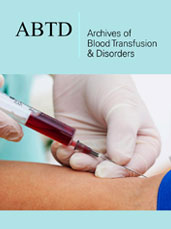- Submissions
Abstract
Archives of Blood Transfusion & Disorders
Feature of Older Patients with Sickle Cell Disease in the Congo
-
Open or Close Ngolet LO*, Malanda F, Ockouango Guelongo Ova JD and Elira Dokekias A
Clinical Hematology Unit, Marien Ngouabi University, Congo
*Corresponding author: Ngolet LO, Clinical Hematology Unit, Marien Ngouabi University, Brazzaville, Republic of Congo. BP: 32, Republic of Congo, Congo
Submission: September 18, 2017; Published: February 26, 2018

ISSN: 2578-0239Volume1 Issue2
Abstract
Background: Despite the high mortality rate of patients with sickle cell disease during the childhood in Africa, their life expectancy is increasing. Consequently, the number of adults is growing. Hence, health providers need to be aware about their clinical and biological pattern.
Patients and Methods: We studied clinical and biological aspects of 47 patients with sickle cell disease and phenotype SS aged 40 years and over from 2011 to 2016.
Results: The mean age was 45 (range: 40-59) years. The female population was older with a mean age of 47 (p=0.05). 23 over 47 (48.9%) had a low monthly income. Older adults presented sever sickle cell related acute morbidity, with a number of 1.83 vasoocclusive crisis, 2 anemic crisis/ blood transfusions and 1.59 admission episodes per year blood transfusion procedure episodes. In our group 57.44% developed a chronic complication. The most frequent complications of older patients with sickle cell disease were elevated tricuspid regurgitant jet velocity on echocardiogram performed on 12/47 patients, avascular necrosis of the femoral head (19.14%) and persistent leg ulcer (8.51%). The mean hemoglobin rate was higher than the rest of the sickle cell disease population.
Conclusion: Sickle cell related acute morbidity is high in older patients. Chronic complications are more frequent in this group and elevated regurgitant jet velocity more common finding.
Keywords: Sickle cell; Congo; Older adults; Morbidity
 a Creative Commons Attribution 4.0 International License. Based on a work at www.crimsonpublishers.com.
Best viewed in
a Creative Commons Attribution 4.0 International License. Based on a work at www.crimsonpublishers.com.
Best viewed in 







.jpg)






























 Editorial Board Registrations
Editorial Board Registrations Submit your Article
Submit your Article Refer a Friend
Refer a Friend Advertise With Us
Advertise With Us
.jpg)






.jpg)













.bmp)
.jpg)
.png)
.jpg)














.png)

.png)



.png)






